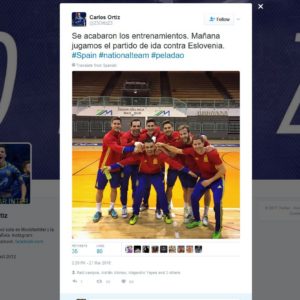Whether a coach or a player, the start of training establishes the atmosphere for the rest of the session. Ideally, it should be competitive, motivating and challenging. Many warm-ups don’t do this as it becomes a process of going through the motions, requiring little thought or engagement from the players.
In this post I will explain the most popular warm up exercise used by top futsal teams including the Spanish National Team and FC Barcelona. The exercise is known as Peladao (ending rhymes with now). The name comes from the Portuguese word pelada which is equivalent to kick about or pick-up game in English. This exercise originates from Brazil but I have seen it mostly used throughout Spain.
These are the basic rules;
- Players are split two teams (all play as outfield players, no goalkeepers)
- If there are odd numbers then extra player plays for whoever has possession at the time and wears a different colour (usually a goalkeeper)
- 2 touch limit
- Goal has to be scored in 6m goal area with the head on the 1st touch
- If a goal is scored, conceding team restart play with a goal kick
- A handball is penalised with an undefended penalty from the centre spot. The taker must kick the ball in the goal with their weaker foot without the ball bouncing beforehand
- Game ends on coaches’ whistle
- If teams are tied at full time then it goes to a sudden death penalty shootout using the same form of penalties as awarded for handballs
Suggested rule variations
- For a goal to be valid all the attackers must be in their opponent’s half when the ball goes in and for every defender who is in the opponent’s attacking half when they concede a goal an extra goal is awarded (so if 2 defenders are in the other half a goal is worth 3)
- Goal allowed with weaker foot as well as head
- Play with 1 touch limit
- If goal is scored, teams reverse which goal they score in and scoring team take a goal kick to restart from where they just scored (encourages a quick transition)
Below is a Spanish 1st Division team playing peladao during training. Note they are using throw ins as this was the rule in the Spanish league at the time.
Sometimes Peladao will be used as a generic name for any fun match played at the start of training. In Spain I used to play one called Total Football, basically a very limited rule game. You had a 1 touch limit and use of the hands were allowed (but you couldn’t catch the ball). There were no outs and the ball could go anywhere in the hall. It doesn’t sound very good but it was quite a lot of fun. However, usually peladao means the game played to the rules above.
Peladao is usually played very competitively but with a fun attitude. There might be a competition of several games played over several training sessions with the same teams with the loser having a forfeit that was decided before. The losers often get teased and I have seen on more than one occasion losing teammates having a temper tantrum.
Benefits of Peladao
- Creates desired atmosphere from the beginning of training
- Players approach training motivated as they know this will be one of the first exercises
- Medium intensity, suitable for after basic mobility and injury prevention exercises have been completed and before full intensity exercises
- Improves team spirit within the squad (Usually!)
- Uses an integrated approach, challenging all four aspects including decision making
- Can use frequently as being a game it will not be repetitive
- Trains goalkeepers in reading the game and to play with their feet
- If the crossing the half rule is used players have to be alert and anticipate transitions
Peladao is an excellent way to start a training session that is enjoyed by players (a rondo/piggy in the middle is another one). It creates an ideal atmosphere for the rest of a training session and that is why many of the world’s top coaches use it in their warm ups. I hope you will find it useful too.

Post a comment